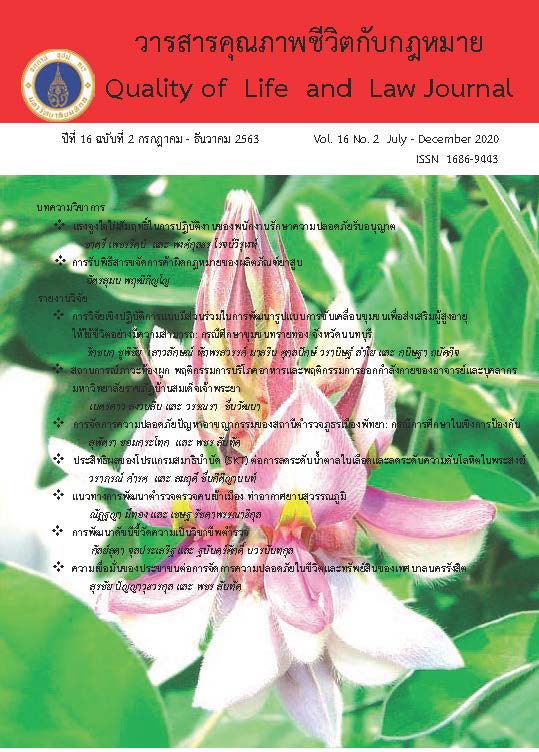การวิจัยเชิงปฏิบัติการแบบมีส่วนร่วมในการพัฒนารูปแบบ การขับเคลื่อนชุมชนเพื่อส่งเสริมผู้สูงอายุให้ใช้ชีวิตอย่างมีความสามารถ: กรณีศึกษาชุมชนทรายทอง จังหวัดนนทบุรี
Main Article Content
บทคัดย่อ
การวิจัยนี้มีวัตถุประสงค์เพื่อศึกษาสภาพของชุมชนและพัฒนารูปแบบการขับเคลื่อนชุมชนเพื่อส่งเสริมผู้สูงอายุให้ใช้ชีวิตอย่างมีความสามารถในพื้นที่ชุมชนทรายทอง จังหวัดนนทบุรี ด้วยการวิจัยเชิงปฏิบัติการแบบมีส่วนร่วมกับผู้นำชุมชน คณะกรรมการชุมชน อาสาสมัครสาธารณสุขประจำหมู่บ้าน ผู้สูงอายุจิตอาสาในชุมชน และบุคลากรสาธารณสุข
ผลการวิจัย พบว่า ชุมชนทรายทองเป็นชุมชนกึ่งเมืองกึ่งชนบท มีการรวมกลุ่มของผู้สูงอายุบางส่วนเพื่อการพัฒนาด้านสุขภาพ สิ่งแวดล้อม และเศรษฐกิจ โดยมีรูปแบบการขับเคลื่อนชุมชนเพื่อส่งเสริมผู้สูงอายุให้ใช้ชีวิตอย่างมีความสามารถ ประกอบด้วย 6 ระยะ ดังนี้ 1) ศึกษาปัญหาและความต้องการของผู้สูงอายุในพื้นที่ 2) สร้างเครือข่ายค้นหาจิตอาสาและแกนนำ 3) ประชุมวางแผนเพื่อกำหนดกิจกรรมส่งเสริมผู้สูงอายุให้ใช้ชีวิตอย่างมีความสามารถ 4) จัดกิจกรรมตามที่กำหนด 5) ทบทวนกิจกรรมและปรับปรุงจากผลการประเมิน 6) ประเมินผลกระบวนการขับเคลื่อนชุมชนเพื่อส่งเสริมผู้สูงอายุให้ใช้ชีวิตอย่างมีความสามารถ และผลการดำเนิน พบว่า ผู้สูงอายุในชุมชนมีการใช้ชีวิตอย่างมีความสามารถ ในด้านสุขภาพ ด้านเศรษฐกิจ และด้านการมีส่วนร่วม ทำให้ผู้สูงอายุสามารถพึ่งพาตนเองในระยะยาวได้ นอกจากนี้ยังพบว่า ปัจจัยที่ทำให้การขับเคลื่อนของชุมชนสำเร็จ คือ การมีเครือข่ายดำเนินงาน ผู้นำชุมชน แกนนำผู้สูงอายุและจิตอาสา ซึ่งเป็นเงื่อนไขสำคัญของการสร้างความเข้มแข็งของผู้สูงอายุ
ข้อเสนอแนะ การขับเคลื่อนชุมชนเพื่อส่งเสริมผู้สูงอายุให้ใช้ชีวิตอย่างมีความสามารถนั้นต้องอาศัยการกำหนดนโยบายเกี่ยวกับผู้สูงอายุในระดับท้องถิ่น และพลังจากทุนทางสังคมในชุมชน คือ ความเข้มแข็งในชุมชน ความร่วมแรงร่วมใจของแกนนำในชุมชน กลุ่มผู้สูงอายุให้เวลากับกิจกรรมการขับเคลื่อนของชุมชน
Article Details
- บทความหรือข้อคิดเห็นใดๆ ในวารสารคุณภาพชีวิตกับกฎหมายเป็
- กองบรรณาธิการไม่สงวนสิทธิ์
เอกสารอ้างอิง
ดวงฤดี ลาศุขะ ทศพร ตําผลศิริ กนกพร สุคำวัง และโรจน์ จินตนาวัฒน์. (2554). การพัฒนาศักยภาพนักศึกษาในการเสริมสร้างกระบวนการพัฒนาสุขภาวะแบบองค์รวมของผู้สูงอายุในชุมชน. วารสารสภาการพยาบาล, 26(ฉบับพิเศษ), 59-69.
เพ็ญจันทร์ สิทธิปรีชาชาญ, ปนัดดา ปริยทฤฆ, ญานิศา โชติกะคาม. (2555).กระบวนการดูแลสุขภาพผู้สูงอายุอย่างมีส่วนร่วมของชุมชนตำบลมาบแค. วารสารพยาบาลทหารบก, 13(2), 8-16.
เล็ก สมบัติ, ศศิพัฒน์ ยอดเพชร, และธนิกานต์ ศักดาพร. (2554). รายงานวิจัยฉบับสมบูรณ์ เรื่อง ภาวะสูงวัยอย่างมีคุณประโยชน์กับการพัฒนาสังคมและเศรษฐกิจใน ประเทศไทย. สำนักงานมาตรฐานการพัฒนาสังคมและความมั่นคงของมนุษย์ สำนักงานปลัดกระทรวงการพัฒนาสังคมและความมั่นคงของมนุษย์
ศูนย์เทคโนโลยีสารสนเทศ และการสื่อสารสำนักงานปลัดกระทรวงการพัฒนาสังคมและความมั่นคงของมนุษย์. (2557). ประชากรผู้สูงอายุไทย: ปัจจุบันและอนาคต. เอกสารประมวลสถิติด้านสังคม 1/2558. กรุงเทพมหานคร: ศูนย์เทคโนโลยีสารสนเทศ และการสื่อสารสำนักงานปลัดกระทรวงการพัฒนาสังคมและความมั่นคงของมนุษย์.
Haines, A. (2009). Asset-based Community Development In: Phillips R. and Pittman R H. (editors.) An Introduction to Community Development. New York: Route ledge Publisher
World Health Organization. (2002). Active Ageing: A Policy Framework. Retrieved from http://www.who.int/ageing/publications/active_ageing/en/.


